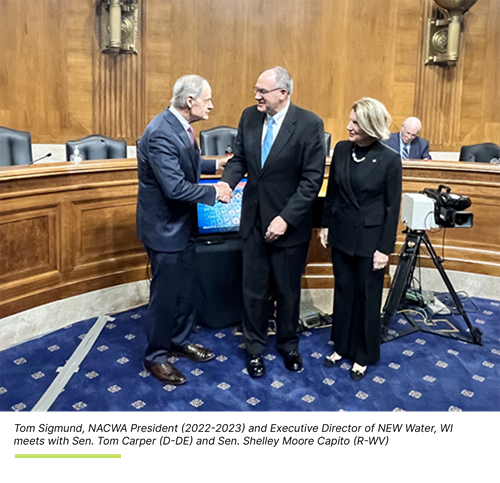NACWA is proud of its role in helping obtain historic infrastructure investments in recent years through the Bipartisan Infrastructure Law (BIL) and Inflation Reduction Act (IRA). These funds are just starting to be distributed and NACWA is advocating for approaches to ensure these funds are invested effectively.
At the same time, NACWA is also battling to ensure sustained strong annual appropriations for core programs like the SRFs and WIFIA. Water, like many other sectors, is being caught in the crosshairs of political pressure to reduce government spending overall, in part because of the large infusion of federal funds through the BIL, IRA, and the resumption of earmarks.The continued importance of federal investment in water continues to be a key message of the annual National Water Policy Fly-In, which NACWA plays the lead role in organizing. NACWA’s advocacy fully recognizes we are stronger when all organizations in our sector are collaborating and has focused its effort to bring the sector together to make water infrastructure funding an equal priority to other infrastructure sectors.

LIHWAP
NACWA continues to push aggressively for additional funding for the existing Low-Income Household Water Assistance Program (LIHWAP) administered by the U.S. Department of Health and Human Services (HHS) while working toward establishment of a permanent low-income water assistance program. The Association requested an additional $1 billion in funding to sustain the current LIHWAP initiative until a permanent program can be established. This spring, a NACWA-initiated partnership with other key water sector groups (and supported by the Association’s Targeted Action Fund) to analyze options for a permanent LIHWAP was completed, culminating in a detailed report, policy recommendations, and press event. NACWA continues to meet regularly with HHS staff to support implementation and continues coordination with stakeholders from beyond the water sector including the energy assistance, consumer and low-income advocate and environmental justice communities to work together toward a permanent program.
Despite working across Congress, HHS, and EPA to advance the federal dialogue around low-income assistance for water and support the continuation of the HHS program, substantial challenges remain in being able to provide any additional funding after the end of the fiscal year on September 30, 2023. Regardless, NACWA is continuing to lead efforts with its water association and low-income assistance partners to prevent an end to the temporary program’s funding and to identify congressional champions for the concept who will be willing to lead the charge in a new Congress.
HHS was successful in extending its deadline for states to fully spend down existing LIHWAP funds by 6 months, which will help to ensure that the dollars that have been provided by Congress for this important program are fully allocated to water customers in need, supporting the case for additional funding nationwide. While certain states were able to quickly get their dollars out the door into customer accounts, the majority of states and tribes had LIHWAP funds remaining as of this summer that they were working aggressively to spend down. HHS announced in August that 1 million households had already benefited from LIHWAP, an important success for this brand-new program which was stood up, thanks in part to strong NACWA advocacy, during the pandemic.
INFLATION REDUCTION ACT (IRA)
To help clean water utilities tap into additional funding, NACWA acted swiftly to help decipher the opportunities in the Inflation Reduction Act (IRA), signed into law in August 2022. The IRA unlocked an unprecedented amount of funding in the form of tax credits, grants, and loan programs for developing clean energy sources and supporting climate mitigation and adaptation. The IRA funds are not specific to clean water utilities but present significant opportunities for utilities to leverage new pots of funding in support of these goals and to garner a greater slice of the federal infrastructure investment “pie”.
The IRA programs and provisions present major opportunities for clean water utilities to secure federal support for initiatives they may be investing in related to clean energy generation, energy efficiency, environmental justice, climate mitigation and resilience. However, the funding is being implemented through numerous federal agencies and new programs, making the process of analyzing and securing funds daunting for utilities and communities.

Recognizing this, the NACWA Board supported a Targeted Action Fund (TAF) project to develop a resource guide focusing on the programs and provisions most relevant to clean water utilities. NACWA held a webinar to walk members through the types of projects that could be supported by the IRA and key programs and released a Guidebook to the IRA aimed at clean water utilities. NACWA hopes that the guidebook will serve as a starting point for utilities to better understand what funding is available and how to access it.
BI-PARTISAN INFRASTRUCTURE LAW FUNDING
Tom Sigmund, then NACWA President (2022-2023) and Executive Director of NEW Water, in Green Bay, Wisconsin, testified before the Senate Environment and Public Works Committee to outline the clean water sector’s experience implementing the Bipartisan Infrastructure Law (BIL) and the need to roll out the funds as quickly and efficiently as possible.
Back